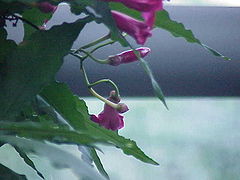Ipomoea horsfalliae
| Ipomoea horsfalliae subsp. var. | Lady Doorly's Morning Glory, Prince Kuhio Vine, Cardinal Creeper | |||||||||||||||||||||||||||||||||||||||||||||||||||||||
|---|---|---|---|---|---|---|---|---|---|---|---|---|---|---|---|---|---|---|---|---|---|---|---|---|---|---|---|---|---|---|---|---|---|---|---|---|---|---|---|---|---|---|---|---|---|---|---|---|---|---|---|---|---|---|---|---|

|
|
| ||||||||||||||||||||||||||||||||||||||||||||||||||||||
| ||||||||||||||||||||||||||||||||||||||||||||||||||||||||
Ipomea horsfalliae is a flowering plant in the family Convolvulaceae known by several common names including Lady Doorly's Morning Glory, Cardinal Creeper, and Prince Kuhio Vine. It is native to the Caribbean and Brazil.
| Standard Cyclopedia of Horticulture |
|---|
|
Ipomoea horsfalliae, Hook. Fls. many, in a 2-branched cyme; corolla bell-shaped, the limb of 5 broad, rounded lobes, very showy. Cosmopolitan tropics.—Perhaps the most popular ipomoea for winter-flowering in a warmhouse. If well treated it will climb 20-30 ft., and will bear hundreds of fls. each day in early winter. May also be grown out-of-doors, but it will not come into bloom till late fall unless the roots are cramped. var. alba, Hort., is I. ternata; Lady Slade has pale rose fls.; var. briggsii, (I. briggsii, Hort.), or Lady Briggs, is generally considered better than the type for most purposes. It is a freer grower and bloomer, the fls. are a rich magenta- crimson, and it roots from cuttings much more readily than I. horsfalliae. This variety makes a fine plant in a 10-in. pot.
|
Cultivation
Propagation
Pests and diseases
Varieties
Gallery
References
- Standard Cyclopedia of Horticulture, by L. H. Bailey, MacMillan Co., 1963
External links
- w:Ipomoea horsfalliae. Some of the material on this page may be from Wikipedia, under the Creative Commons license.
- Ipomoea horsfalliae QR Code (Size 50, 100, 200, 500)
